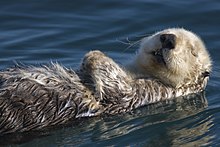Enhydra
| Enhydra | |
|---|---|

| |
| Sea otter (Enhydra lutris) | |
| Scientific classification | |
| Domain: | Eukaryota |
| Kingdom: | Animalia |
| Phylum: | Chordata |
| Class: | Mammalia |
| Order: | Carnivora |
| Family: | Mustelidae |
| Subfamily: | Lutrinae |
| Genus: | Enhydra Fleming, 1828 |
| Species | |
|
Enhydra lutris - Sea otter | |
Enhydra is a genus of mustelid that contains the sea otter and two extinct relatives. It is the only extant genus of the bunodont otters group, referring to otters with non-blade carnassials with rounded cusps.[1]
Sea otters probably diverged from other otters during the Pliocene, approximately 5 mya.[2] They probably arose from the closely related Enhydritherium, a bunodont otter endemic to North America during the late Miocene and early Pliocene epochs.[1]
Enhydra reevei, the oldest known species, has its origins in the Atlantic, suggesting this may have been where sea otters originated.[2] Fossil evidence indicates the Enhydra lineage became isolated in the North Pacific approximately 2 million years ago, giving rise to the now-extinct Enhydra macrodonta and the modern sea otter.
References
[edit]- ^ a b "Enhydritherium terraenovae". Florida Museum of Natural History. Retrieved 10 October 2022.
- ^ a b Davis, Randall W. (2019). Marine Mammals: Adaptations for an Aquatic Life. Springer International Publishing. p. 21. ISBN 9783319982809.
| |||||||||||||||||||||||||||||||||
| |||||||||||||||||||||||||||||||||
| Enhydra | |
|---|---|
| Authority control databases: National |
|---|
This article about a carnivoran is a stub. You can help Wikipedia by expanding it. |







